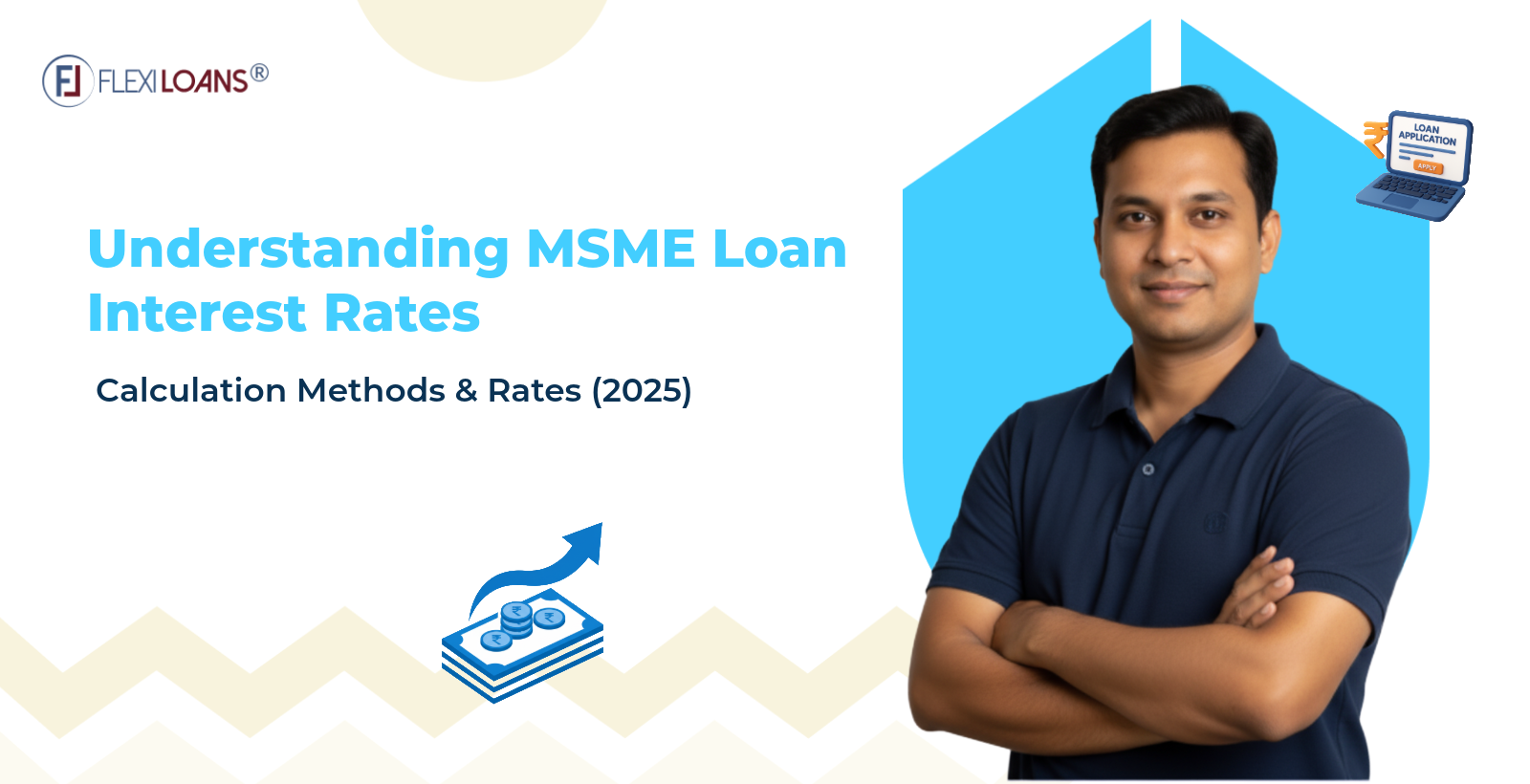Apr 04, 2025
Apr 04, 2025

The Reverse Charge Mechanism (RCM) under Goods and Services Tax (GST) shifts tax liability from the supplier to the recipient. Typically, the seller collects GST and deposits it with the government. However, under RCM, the recipient is required to pay the tax directly.
This mechanism helps bring unregistered vendors into the tax system, ensuring better compliance and higher revenue collection. Additionally, it prevents tax evasion by holding registered businesses accountable for transactions with unregistered suppliers.
Understanding RCM is essential for businesses to comply with tax laws, manage cash flow efficiently, and avoid penalties. As tax obligations under RCM can affect working capital, businesses often seek financial solutions such as FlexiLoans to maintain smooth operations while fulfilling tax responsibilities.
What is the Reverse Charge Mechanism (RCM) Under GST?
For a comprehensive understanding of RCM, including its applicability and compliance requirements, you can refer to our detailed article on Reverse Charge Under GST.
Why is RCM Important?
The Reverse Charge Mechanism plays a crucial role in strengthening tax compliance and ensuring fair taxation. Its significance can be understood through the following points:
1. Brings Unregistered Suppliers Under the Tax Structure
Many small vendors and service providers operate without registering under GST. If a registered business transacts with them, the government might lose tax revenue. By shifting tax liability to the recipient, RCM ensures that transactions with unregistered suppliers still generate tax revenue.
2. Reduces Tax Evasion by Making Recipients Responsible for Tax Payments
RCM ensures GST payment even when the supplier fails to collect it, preventing tax leakage. Since the registered recipient is legally obligated to deposit tax, authorities can track payments more effectively. This discourages businesses from bypassing GST regulations by sourcing goods and services from unregistered vendors.
3. Helps the Government Improve Revenue Collection and Compliance
One of the primary objectives of GST is to ensure a transparent and structured taxation system. RCM assists in boosting government revenue by covering transactions that might otherwise go untaxed. Additionally, it enhances compliance, as businesses must record and report these transactions while filing returns.
4. Ensures Seamless Tax Reporting for Businesses Dealing with Unregistered Vendors
Companies engaging with unregistered suppliers must still maintain proper records for tax compliance. RCM requires businesses to issue self-invoices and report transactions in GSTR-3B returns, creating a clear audit trail. This simplifies tax reporting, reducing the risk of errors and penalties during assessments.
Impact of RCM on Businesses
For businesses, RCM affects cash flow and compliance obligations. Businesses must pay GST under RCM in cash since they cannot use Input Tax Credit (ITC), which may create liquidity challenges. Moreover, accurate record-keeping and timely tax payments become critical to avoid penalties and interest charges.
To ensure smooth financial operations while managing RCM liabilities, many businesses opt for short-term financing solutions. Platforms like FlexiLoans offer collateral-free business loans, allowing companies to maintain liquidity while fulfilling tax obligations. By leveraging such financial support, businesses can avoid cash shortages and focus on growth.
Example of Reverse Charge Mechanism
When a registered entity hires an unregistered legal consultant, the business must pay GST under RCM instead of the consultant. Similarly, if a company rents a vehicle from an unregistered supplier, it must pay tax on the transaction.
Since RCM affects cash flow, businesses must plan finances efficiently. Many enterprises choose funding solutions like FlexiLoans, which offer collateral-free loans to manage tax liabilities and operational costs.
Applicability of Reverse Charge Mechanism (RCM) in GST
To delve deeper into the scenarios where RCM is applicable, explore our post on Top 10 GST Features in India, which discusses RCM complexities.
1. RCM on Specified Goods & Services
The government mandates RCM on certain goods and services, particularly when the supplier lacks registration. Some examples include:
- Cashew nuts: When procured from an agriculturist.
- Silk yarn: When bought directly from farmers.
- Tobacco leaves: When supplied by growers.
2. RCM on Services from Unregistered Suppliers
If a registered entity avails services from an unregistered vendor, the recipient must handle GST payment. Some common examples include:
- Legal services: When an advocate provides legal consultancy.
- Renting of vehicles: If a business hires a vehicle from an unregistered individual.
- Goods Transport Agency (GTA): If an unregistered transporter delivers goods.
3. RCM on Import of Goods and Services
Businesses pay GST under RCM when they import services from suppliers operating outside India. For instance, a company using software services from a foreign provider is required to pay tax under RCM.
4. RCM for E-commerce Operators
E-commerce platforms facilitating transactions for unregistered suppliers must pay GST under RCM. Businesses like Swiggy and Zomato collect GST on behalf of unregistered restaurants that use their platforms.
Since RCM increases financial obligations, businesses must have sufficient funds to meet tax requirements. FlexiLoans provides working capital loans, allowing businesses to manage expenses without disrupting operations.
List of Goods and Services Under RCM in GST
The government mandates the Reverse Charge Mechanism (RCM) for specific goods and services to ensure tax collection even when the supplier is unregistered. Below is a detailed list of key items and services where RCM applies:
| Goods/Services | Supplier Type | Taxpayer Liable to Pay GST |
|---|---|---|
| Cashew nuts | Agriculturist | Registered Business |
| Silk yarn | Agriculturist | Registered Business |
| Tobacco leaves | Agriculturist | Registered Business |
| Legal Services | Advocate/Law Firm | Business Recipient |
| GTA (Transport) | Unregistered Transporter | Recipient of Service |
| Import of Services | Foreign Supplier | Indian Business Recipient |
| Renting of Vehicles | Unregistered Supplier | Registered Business |
A complete list of RCM goods and services can be found in Notification No. 13/2017 and 4/2017 under CGST Rules. For a detailed breakdown of goods and services under RCM, refer to our article on Reverse Charge Under GST.
Why is RCM Applied to These Goods and Services?
- Unregistered suppliers like farmers and individual service providers do not have GST registration. Without RCM, such transactions would escape taxation.
- Government entities often supply items like confiscated goods and lottery tickets. RCM ensures taxation while avoiding unnecessary compliance burdens on these bodies.
- Imports and foreign services require RCM since international suppliers do not fall under Indian GST laws.
- Critical business services like legal consultancy, security, and manpower supply operate under RCM to regulate compliance across industries.
A complete and updated list of all goods and services under RCM is available in Notification No. 13/2017 and 4/2017 under CGST Rules.
Managing Cash Flow for RCM Payments
Since RCM requires immediate tax payment in cash, businesses often face cash flow challenges. Timely compliance is crucial to avoid interest and penalties on unpaid GST. To ensure smooth financial management, many businesses opt for short-term working capital loans from platforms like FlexiLoans.
FlexiLoans provides hassle-free financing to help businesses meet tax obligations without disrupting operations. With flexible repayment options, companies can ensure compliance while maintaining sufficient liquidity for daily expenses.
How to Calculate and Pay GST under RCM?
Businesses must follow a systematic approach when calculating and paying GST under RCM.
Step 1: Identify RCM Transactions
Determine if the supplier is unregistered or if the goods or services fall under RCM.
Step 2: Calculate GST Liability
GST calculation follows a straightforward formula:
GST Payable=Transaction Value×GST Rate\text{GST Payable} = \text{Transaction Value} \times \text{GST Rate}GST Payable=Transaction Value×GST Rate
Example Calculation:
- Rent paid to an unregistered supplier = ₹50,000
- GST Rate = 18%
- GST Payable under RCM = ₹50,000 × 18% = ₹9,000
Step 3: Pay GST in GSTR-3B Return
Businesses must settle RCM liability in cash because they cannot use Input Tax Credit (ITC) for this payment.
Step 4: Claim Input Tax Credit (ITC)
After paying GST under RCM, businesses can claim ITC in the following GST return period, reducing the overall tax burden.
Many businesses seek financial assistance to cover RCM tax obligations. FlexiLoans provides tailored financing solutions, ensuring smooth cash flow without affecting daily operations.
Reverse Charge Compliance and GSTR Filing
Reporting RCM Transactions in GST Returns
- GSTR-3B – Declare RCM liability and pay tax.
- GSTR-1 – Reporting not required since the recipient is liable.
- GSTR-2A & GSTR-2B – ITC credit for RCM appears in these forms.
Invoice Requirements Under RCM
- The recipient must issue a self-invoice for RCM purchases.
- The invoice must include the tax amount and supplier details.
Due Dates for RCM Tax Payment
- Businesses must pay GST under RCM in the same tax period as the transaction.
- Delayed payments attract interest and penalties.
Conclusion
The Reverse Charge Mechanism (RCM) ensures tax compliance, particularly for transactions involving unregistered suppliers. Businesses must calculate RCM liability accurately, file returns on time, and claim ITC efficiently.
Proper adherence to RCM rules prevents penalties and supports smoother financial planning. However, since RCM impacts cash flow, businesses may require additional funding. FlexiLoans provides flexible financing solutions, enabling businesses to manage tax payments without disrupting operations.
By staying compliant and managing finances effectively, businesses can navigate RCM challenges and focus on growth without financial stress. of Tax under the RCM – Reverse Charge Mechanism Method.
FAQs
RCM shifts the tax liability from the supplier to the recipient.
Yes, businesses can claim ITC in the next GST return period.
Failure to comply with RCM obligations leads to interest charges and penalties.
Declare RCM liability in GSTR-3B and claim ITC later.
Yes, RCM applies to imported services from foreign suppliers.







